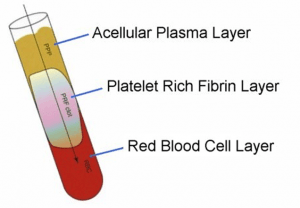PRF/ Platelet Rich Fibrin is an amazing, relatively recent, all natural way to help promote healing, and has extensive beneficial use in dentistry.
PRF is proven to assist in healing and recovery from dental procedures including complex dental surgeries or a simple tooth extraction. One of the latest innovations in oral surgery is the use of PRF for tissue engineering.
What is PRF?
PRF is a substance which is found and extracted from your own blood. When it is separated from the blood, it has a gelatine like composition. Since it is made entirely from your own cells, it is completely biocompatible with your own body. It possesses amazing natural healing properties, and is completely in line with our Holistic Approach to oral health. The PRF gets applied directly to areas that require healing, such as cavitation left behind from an extracted tooth. PRF not only speeds the healing process, but it has proven to help heal the wounds to a much greater extent than had the wound been left to heal on its own.
How is PRF extracted from your body?
We draw a small sample of your blood in a glass container without adding any coagulants or thrombin. We then place that vile in a centrifuge which spins the vile of blood at 3000 rpm for roughly ten minutes. Through the spinning process, the blood gets separated into three layers: plasma at the top, red blood cells in the bottom, and fibrin clot in between.

Composition of PRF
- Leukocytes
Leukocytes are the blood cells which fight infection. They are also known as white blood cells.
- Platelets
Platelets are the type of blood cells which help in forming a blood clot. When you have a wound, you see that initially, you bleed and then a blood clot forms and bleeding stops. Platelets form the clots at the bleeding blood vessels; thus, there is no more bleeding.
- Autologous fibrin
Fibrin is a protein which forms a mesh-like structure. Fibrin is a crucial component as it binds all the components of the clot together. Fibrin has a major role in hemostasis (stopping bleeding,) and wound healing.
- Cytokines
Cytokines are proteins which have anti-inflammatory properties. Swelling, pain, loss of function, increased temperature, and redness are the signs of inflammation. By fighting these signs, cytokines help in wound healing.
- Stem cells
Stem cells are the cells which can convert to any type of cells. Be it bone, blood, or muscle. Thus, they help in regenerating tissues and wound healing.
How different is PRF from a blood clot?
PRF is more:
- Homogenous/ alike/ equal structure
- We can place it in the place that we want
- Stable
Here are few uses of PRF in dentistry
- Helps to restore peri-implant bone
When you lose your natural teeth, you can replace them with implants.
*Implants are natural teeth-like structures which are deep-seated in your jaws just like your natural teeth. They also last longer, almost for a lifetime if you maintain them well.
If you have less bone around your implants, PRF helps in depositing healthy new bone around them. By attracting osteoblasts (bone-forming cells) to the area of concern as well as with the help of stem cells, PRF helps in bone regeneration.
- Preserves alveolar ridge
The alveolar bone is the jaw bone which supports your teeth. After removing your teeth, whatever bone remains is known as the alveolar ridge. Sufficient jaw bone makes it good for implants or helps you retain your dentures (artificial teeth set.)
- Heals periodontal defects
Teeth get weak or loose when there is bone resorption (destruction) around them. PRF generates new bone and thus, improves the health of your teeth. PRF can reduce the probing depths too.
*Probing depth is the depth of the pocket. Usually, gums line your teeth and are attached to your teeth. When there are bone diseases, the bone resorbs, and gums separate from your teeth. The extent of separation of gums is measured by a probe and is known as the probing depth. By facilitating bone deposition, PRF reduces the probing depth.
- PRF is useful in oral cancer
After cancer surgery, PRF can reconstruct the bony defects.
- Helps in gum regeneration
PRF also helps to enhance the gum volume.
- Heals mucosal margins which sutures can’t heal
Doctors suture when necessary, for instance after surgeries to facilitate healing. PRF helps in joining mucosa (soft tissue) which even sutures fail to heal.
- Prevents and treats infections
Thanks to leucocytes. In addition, PRF has antibacterial properties.
- Speeds up wound healing
- Cytokines prevent inflammation, thus, speed up wound healing.
- PRF provides a sustained release of growth factors. Also, the growth factors in your blood help your bone heal better when they come in contact with PRF. Growth factors speed up the healing considerably.
- PRF facilitates angiogenesis (formation of new blood vessels) at the site of wound which contributes to healing.
- PRF also directs new cells such as epithelial cells (skin cells) to the area of wound so that fresh skin cells can cover the wound.
- Helps to heal the palatal wound after gingival graft.
- PRF also attracts other cells such as bone forming osteoblasts and blood vessel-forming cells which are essential for regenerating healthy tissue. It also keeps undesirable cells away.
- PRF is self-degradable. It degrades within one to two weeks. By cross-linking the fibrin, we can delay the degradation by another two weeks. In a few cases especially implants, PRF reduces the healing time by half.
- Maxillary sinus augmentation
Some studies say PRF is probably the only material which can augment maxillary sinus floors.
*Maxillary sinus augmentation is a process wherein the height of posterior maxilla (upper jaw bone) is increased by means of bone grafting (placing extra bone.)
Maxillary sinus augmentation is also known as the sinus lift procedure. Sometimes there can be a perforation in the maxillary sinus during the sinus lift procedure and go unnoticed. PRF heals such perforations by depositing bone.
*Sinus is an empty space lined by bones. Perforation is when the wall of sinus ruptures.
- PRF reduces osteitis
PRF reduces osteitis (inflammation of bone) by up to 90%.
PRF is a natural surgical additive, which carries low risks and provides good results. PRF is suitable to be used alone as well as in combination with other biomaterials.
Reference:
- https://www.ncbi.nlm.nih.gov/pmc/articles/PMC4509294/
- https://www.ncbi.nlm.nih.gov/pmc/articles/PMC5536100/
- https://www.ncbi.nlm.nih.gov/pmc/articles/PMC5676313/
- https://www.mayoclinic.org/symptoms/high-white-blood-cell-count/basics/definition/sym-20050611
- https://www.mayoclinic.org/diseases-conditions/thrombocytopenia/symptoms-causes/syc-20378293
- https://www.nottingham.ac.uk/nursing/practice/resources/cardiology/acs/fibrin.php
- https://www.ncbi.nlm.nih.gov/pmc/articles/PMC5536100/
- https://www.ncbi.nlm.nih.gov/pmc/articles/PMC2785020/

